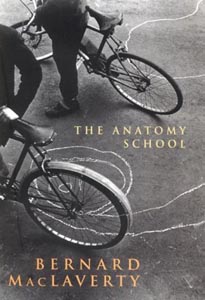Dorothy Johnston
Bernard MacLaverty’s The Anatomy School is in many ways a familiar rite of passage story of a schoolboy growing up in Northern Ireland in the Sixties. The central character, Martin, attends a Catholic grammar school to which he’s won a scholarship but has failed his exams and must repeat his final year. Since his working class widowed mother must pay the fees for this repeated year, there is already a degree of guilt and pressure. It is imperative that he pass.
His thoughts are suffused with sexual curiosity and confusion, while his exterior life revolves around his relationships with two friends; Kavanagh, the academic sporty friend Martin idealises and wants to live up to, and intellectual, subversive, disquieting Blaise, who disturbs Martin’s confidence, and keeps him intellectually on the back foot.
Blaise encourages the others to question religion, particularly their own Catholicism as they also experience specific reactions to the priests and their personalities. There are reminders that this is the Sixties, a time of opening up, tolerance of difference and questioning of old certainties. Meanwhile there is the dawning awareness of the relevance of politics, and its relation to the education they are undergoing, and the particular directions in which their minds are stimulated. In the background are the Troubles, like some amorphous chaos at the edge of their thinking.

It is some time before the resonance of the title sinks in. The boys consider and discuss science in relation to religion, art and history. They dissect ideas, as later one of them dissects bodies. Where is the location of the soul? Should Martin become a priest? What is sex or pornography? How do the different parts of a woman’s body initiate the sensations that they do? Knowledge once attained leads the learner into a new country, and the act of learning itself can be extraordinarily strange.
MacLaverty’s prose reaches down, stills the moment, and examines it. The seemingly simple image or piece of dialogue becomes strange, bizarre even, and then either turns back to the bland, or becomes ugly or funny. The boys contemplate and discuss the image of a rower. His back is to the future, he can only see the past.
The boys’ searching dialogue is counterpointed with the whimsical conversations undergone by his mother and her guests at her frequent tea and sandwiches evenings. The dialogue is comic, and while MacLaverty’s ear is good it verges at times towards the patronising. Yet these discussions also throw up instances of uncomfortable probing. One of his mother’s friends questions the priest on a point of Catholic ritual. She can’t help wanting to pierce and perceive for a moment what must, by the definition of its existence, remain a mystery.
The characters are often familiar, and their concerns repetitive. In a novel with such a great deal of dialogue dealing with ideas, Kavanagh and Blaise are sometimes reduced to ciphers. In the case of the female characters, they frequently fulfil a symbolic purpose which can outweigh their reality. MacLaverty’s treatment of the two young female characters Martin becomes involved points to the Christian Mary the mother / Mary the whore dichotomy and the misogyny which this entails, without any implied criticism, but instead a wholehearted acceptance of this point of view as a legitimate one. Given the themes and characters of his previous novels and short stories it seems strange that this would be MacLaverty’s intention. As written here however, it seems to be as clear a statement as any he makes.
It is of course the main character Martin, with whom we go through and suffer the tortuous twistings required of the plot, both grave and hilarious. It is a serious novel with a lot of funny parts. MacLaverty has taken the familiar, the well worn, and held it up the light. He has teased out meanings and metaphors and possibilities from material which at first seems unpromising. This is a tribute to his undoubted skills. However, the shallowness of the characters surrounding Martin, and their, at times, stereotypical responses and motives, leave an emptiness at the centre of the novel, which is not something one normally expects from a writer of MacLaverty’s abilities.
